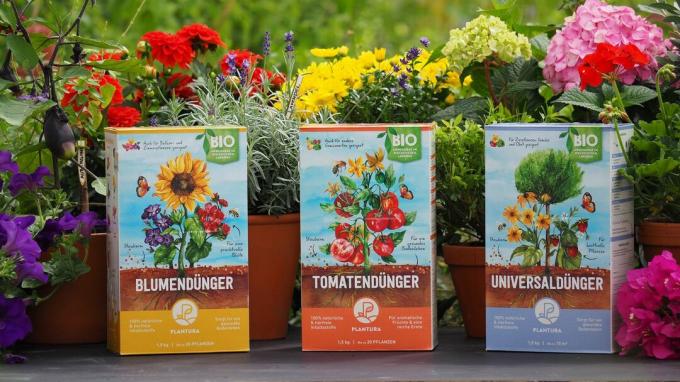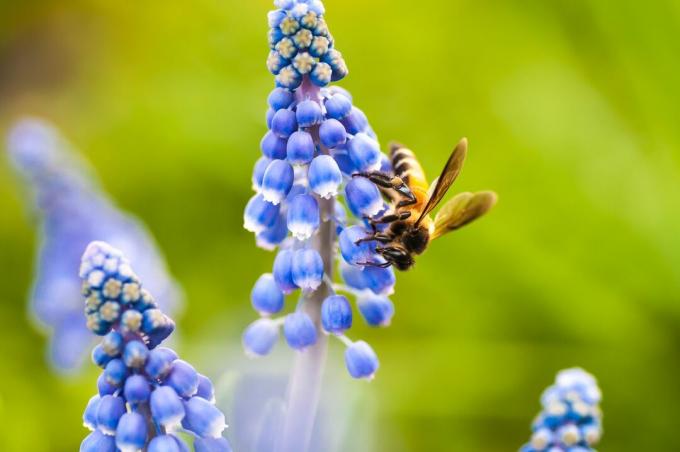Insects are simply part of a healthy garden. Here you can find out what you need to consider to make your garden insect-friendly.

Whether as a pollinator for all kinds of plants, as beneficials against unloved herbivores or as food for birds and hedgehogs - insects fulfill a variety of important tasks in nature and of course in our gardens. Unfortunately, the small animals are having a harder time: In recent years, the number of many insect populations has fallen dramatically. A particularly prominent example of the difficult situation of insects is probably the death of bees, but also other insect species such as butterflies or bumblebees fight for their survival. Fortunately, however, it is not that difficult to do something good for insects: if you do something good for the animals in your own Garden offers a place of retreat, helps the little helpers enormously and can thus ensure a greater variety of species care for. In this article you will find out how you can make your garden particularly insect-friendly.
contents
- 1. Create an insect friendly garden
- 2. What do insects eat? The right choice of plants
- 3. Organic instead of chemicals: fertilize and spray properly
- 4. Insect friendly variety
- 5. Create retreats for insects
- 6. Remove death traps
Insects always ensure life in the garden. Anyone who wants to strengthen their backs for the beautiful and fascinating animals should definitely follow these six tips.
1. Create an insect friendly garden
Do you need a lot of work and a lot of space to create an insect-friendly garden? Fortunately, that's not true: In fact, even small gardens and even a balcony can be designed to be insect-friendly. The first step is usually the most difficult - where should you start? It is best to start with a small inventory and write down what is already available in the garden and balcony. It is important to also write down the site conditions so that all plants are later placed in suitable places.

Now the actual planning begins: Here it is important to consider which areas should be redesigned and which beds suit your personal lifestyle. A wildflower meadow, for example, is more suitable for people who want a garden that is particularly easy to maintain. Self-sufficient people, on the other hand, do not want to do without their vegetable patch, while others prefer a blooming perennial patch. The garden becomes particularly insect-friendly if you also plan “wild corners” with piles of leaves, dry stone walls or a small watercourse. Now you can start with the pre-selection of the new plants: it is important to choose insect-friendly ones Leave plants in the garden and replace less insect friendly plants with more suitable alternatives substitute. Also consider the different flowering times of the plants - so that bees, butterflies and Co. feel comfortable, the garden should be planted in such a way that the animals can grow from spring to late autumn find food. Once the planting plan has been created, the actual work can begin.
2. What do insects eat? The right choice of plants
The garden is in full bloom - mustn't that be a feast for insects? Unfortunately not, because in fact many plants impress with their great flowers, but hardly produce any nectar. Unfortunately, some of these plants are particularly popular with many gardeners: geraniums (pelargonium) and dahlias (dahlias) are true eye candy, but leave useful insects empty-handed. Also double rose varieties (pink) or asters (aster) are not optimal for an insect pasture. On the other hand, they are more suitable insect friendly flowers, like the well-known dandelion (Taraxacum officinale).

Even bee friendly herbs are suitable for every garden and make beneficial animals and people happy. Nobody even has to do without flowering perennial beds, because you can take them with you insect-friendly perennials and shrubs equip. In addition, fruit trees are popular food sources for insects – bee friendly trees should therefore not be missing in any larger garden. On the other hand, they are suitable for smaller gardens insect-friendly climbing plants - these can climb up the garden fence or the house wall to save space and not only look beautiful, but also provide a welcome source of food for insects. In the video we show you how to create an insect-friendly flower bed yourself.
Tip: With an insect seed mix like that Plantura bee pasture save yourself the hassle of assembling insect-friendly plants in your garden.
3. Organic instead of chemicals: fertilize and spray properly
When aphids nibble on the vegetables or unloved weeds sprout in the beds, many hobby gardeners resort to insecticides or weed killers. But this not only drives away the annoying visitors - beneficial insects such as bees and butterflies can often not tolerate the chemical clubs and become unwanted victims. Therefore, it makes sense to omit the chemicals - many pests can also use all kinds of home remedies such as nettle manure or by choosing the right plant partner. When it comes to weeds, it is sometimes even worth taking a closer look, because there are many Weeds aren't just edible, but actually very tasty. But you should not only be careful when spraying: mineral artificial fertilizers not only lack a lasting effect, they are also toxic for humans and animals in many cases. The much better option is organic fertilizers like ours Plantura fertilizer which, due to their composition, have a long-term effect and do not pose any danger to insects.

4. Insect friendly variety
An English lawn may look neat and tidy, but it is a nightmare for many insects: the animals often cannot find enough food to survive on such monocultures. But even richly flowering summer meadows cannot provide enough food for bees, bumblebees and co Planting in summer provides an abundance of food sources, but in spring and autumn the little helpers come up in vain foraging. To ensure that the insects are supplied all year round, it is worth choosing as diverse a planting as possible. early bloomers like that Spring Crocus (Crocus vernus) or the grape hyacinth (Muscari armeniacum) ensure a good start to the year for insects. In late summer, on the other hand, autumn anemones (Anemone hupehensis) or the ivy (Hedera helix) to bloom, providing one last feast before winter.
Seed mixtures like the are therefore ideal for an insect-friendly garden Plantura beneficial insect magnet suitable: Due to the large number of different native plant species contained in the mixture, it is tempting not only offers various beneficial insects, but also provides a food source for over a long period of time Insects.

5. Create retreats for insects
Trimmed hedges and tidy beds are a joy for many people, but a joy for insects Nightmare: most of them can no longer find any retreats in the garden in which to make their nests can build. This can be remedied by “wild corners”, where the gardener changes as little as possible. Deadwood, piles of leaves and old stalks provide ideal shelter for many insects. Thanks to wild herbs and perennials, such a corner does not have to look untidy at all, but exudes its very own charm.
Another great option for an insect retreat is this Planting a dry wall or a heap of stones - these sunny places are ideal spots for warmth-loving insects in particular and are also extremely easy to care for. A pond not only cools you down in summer, but is also home to numerous species of insects, such as the beautiful dragonfly. But there are also great alternatives for smaller gardens: Insect hotels do not need much space, but are still a wonderful way to help wild bees and Co. So that the insects feel comfortable in their new house, you should make sure that the insect hotel is well made. The location is also crucial: Full sun but protected from the weather are ideal conditions for attracting the animals. If you also place the insect hotel near insect-friendly plants, the accommodation will soon be teeming with beneficial insects.

6. Remove death traps
Nobody really likes mosquitoes - especially on mild summer nights, the annoying bloodsuckers can spoil the evening. No wonder, then, that many garden owners set up UV traps to protect them from the pests. But also adhesive strips for flies or traps with scented bait can be found again and again on terraces. Unfortunately, these devices not only catch annoying pests, but also numerous useful insects and are therefore anything but insect-friendly. Rather bet on one Mosquito repellent plants: lemon balm (Melissa officinalis), rosemary (Rosmarinus officinalis) or walnut (Juglans regia) deter biting insects and at the same time provide food for beneficial insects.

But not only mosquito repellent can become a death trap for insects: Few know that light pollution is also harmful to many insects. Since the animals are magically attracted to the light, they often circle the garden lights until they are completely exhausted or even crawl into the lamps - a death sentence. If possible, do without permanent garden lighting at night, for example by use a timer - this not only saves electricity, but also helps the Insects.
If you want to learn more about how to make your Turn your garden into a real paradise for bees if you can, take a look here.
